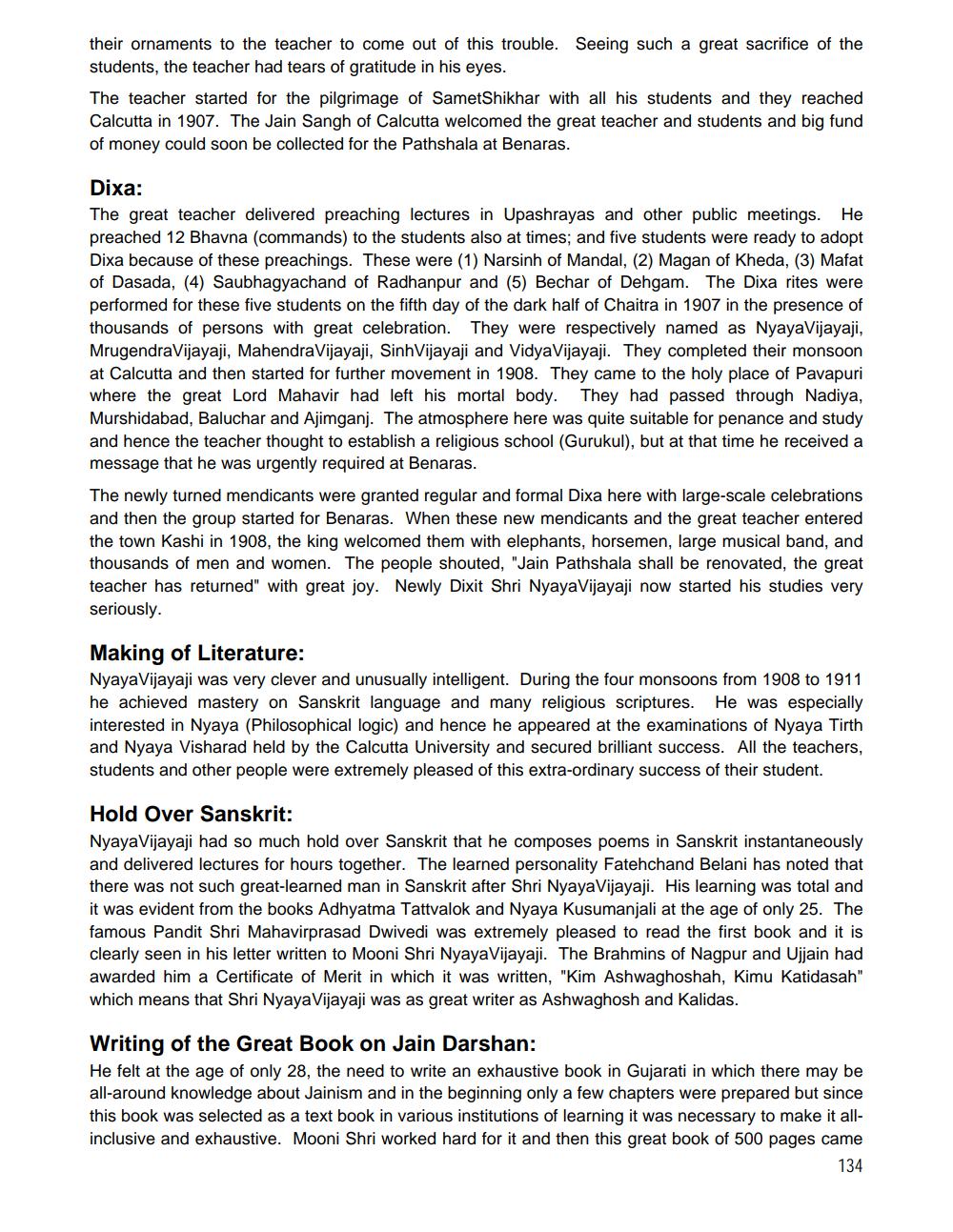________________
their ornaments to the teacher to come out of this trouble. Seeing such a great sacrifice of the students, the teacher had tears of gratitude in his eyes.
The teacher started for the pilgrimage of SametShikhar with all his students and they reached Calcutta in 1907. The Jain Sangh of Calcutta welcomed the great teacher and students and big fund of money could soon be collected for the Pathshala at Benaras.
Dixa:
The great teacher delivered preaching lectures in Upashrayas and other public meetings. He preached 12 Bhavna (commands) to the students also at times; and five students were ready to adopt Dixa because of these preachings. These were (1) Narsinh of Mandal, (2) Magan of Kheda, (3) Mafat of Dasada, (4) Saubhagyachand of Radhanpur and (5) Bechar of Dehgam. The Dixa rites were performed for these five students on the fifth day of the dark half of Chaitra in 1907 in the presence of thousands of persons with great celebration. They were respectively named as NyayaVijayaji, MrugendraVijayaji, MahendraVijayaji, SinhVijayaji and Vidya Vijayaji. They completed their monsoon at Calcutta and then started for further movement in 1908. They came to the holy place of Pavapuri where the great Lord Mahavir had left his mortal body. They had passed through Nadiya, Murshidabad, Baluchar and Ajimganj. The atmosphere here was quite suitable for penance and study and hence the teacher thought to establish a religious school (Gurukul), but at that time he received a message that he was urgently required at Benaras.
The newly turned mendicants were granted regular and formal Dixa here with large-scale celebrations and then the group started for Benaras. When these new mendicants and the great teacher entered the town Kashi in 1908, the king welcomed them with elephants, horsemen, large musical band, and thousands of men and women. The people shouted, "Jain Pathshala shall be renovated, the great teacher has returned" with great joy. Newly Dixit Shri NyayaVijayaji now started his studies very seriously.
Making of Literature:
Nyaya Vijayaji was very clever and unusually intelligent. During the four monsoons from 1908 to 1911 he achieved mastery on Sanskrit language and many religious scriptures. He was especially interested in Nyaya (Philosophical logic) and hence he appeared at the examinations of Nyaya Tirth and Nyaya Visharad held by the Calcutta University and secured brilliant success. All the teachers, students and other people were extremely pleased of this extra-ordinary success of their student.
Hold Over Sanskrit:
Nyaya Vijayaji had so much hold over Sanskrit that he composes poems in Sanskrit instantaneously and delivered lectures for hours together. The learned personality Fatehchand Belani has noted that there was not such great-learned man in Sanskrit after Shri Nyaya Vijayaji. His learning was total and it was evident from the books Adhyatma Tattvalok and Nyaya Kusumanjali at the age of only 25. The famous Pandit Shri Mahavirprasad Dwivedi was extremely pleased to read the first book and it is clearly seen in his letter written to Mooni Shri Nyaya Vijayaji. The Brahmins of Nagpur and Ujjain had awarded him a Certificate of Merit in which it was written, "Kim Ashwaghoshah, Kimu Katidasah" which means that Shri Nyaya Vijayaji was as great writer as Ashwaghosh and Kalidas.
Writing of the Great Book on Jain Darshan:
He felt at the age of only 28, the need to write an exhaustive book in Gujarati in which there may be all-around knowledge about Jainism and in the beginning only a few chapters were prepared but since this book was selected as a text book in various institutions of learning it was necessary to make it allinclusive and exhaustive. Mooni Shri worked hard for it and then this great book of 500 pages came
134




